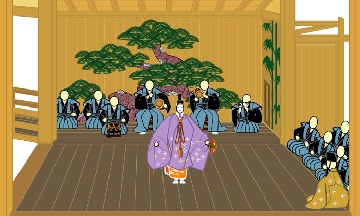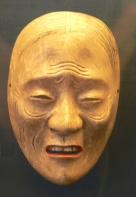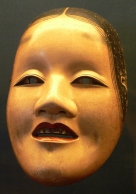|
Literature
/ Art / Cross Cultural / History / Biography
|
|
Noh Theater
Performer's Mask
|
Japanese Romance
A Book
Review of The House of Kanze, by Nobuku Albery
|
|
by Hakim Bey
|
 I'd like to draw
your readers' attention to a new novel, The House of Kanze by Nobuko
Albery, a historical romance about the founder of the Noh theater of
Japan, Zeami, who at the age of 12 became the beloved of the Ashikaga
Shogun Yoshimitsu, ruler of all 14th-century Japan. Zeami was
reputedly a most beautiful and brilliant boy actor/dancer; the Shogun
was a man of incredible erudition and taste. Their love affair
lasted until Zeami's coming of age at about 17; thereafter the Shogun
remained a friend and patron, thanks to whose support Zeami was able to
develop and crystallize the Noh in the form it still retains. I'd like to draw
your readers' attention to a new novel, The House of Kanze by Nobuko
Albery, a historical romance about the founder of the Noh theater of
Japan, Zeami, who at the age of 12 became the beloved of the Ashikaga
Shogun Yoshimitsu, ruler of all 14th-century Japan. Zeami was
reputedly a most beautiful and brilliant boy actor/dancer; the Shogun
was a man of incredible erudition and taste. Their love affair
lasted until Zeami's coming of age at about 17; thereafter the Shogun
remained a friend and patron, thanks to whose support Zeami was able to
develop and crystallize the Noh in the form it still retains.
 Interestingly,
their affair shocked the Japanese aristocracy not
because of its homosexuality (a more-or-less accepted part of samurai
society) but because the boy was an actor, and hence untouchable.
Nobuko Albery's version of the story is well researched but
structurally somewhat clunky -- at times downright amateurish -- but
nevertheless highly readable. In fact, its stylistic naivete adds
to its charm. I have often imagined to myself what the meeting of
Zeami and the Shogun must have been like (in fact, the scene lies
behind certain aspects of my fantasy novel Crowstone) -- and Ms Albery
did not disappoint me in her handling of the encounter. She's at
her best describing the theater moments; her grasp of Noh aesthetics
seems to me lacking in profundity but rich in imaginative
participation. Readers like us may have some objections to
certain of her ideas about man/boy love, but on the whole, The Subject
is treated with much more sympathy than any straight male author has
ever attained, and in fact, the affair between Zeami and the Shogun is
handled very sympathetically, and indeed, very romantically.
(It's a mystery to me why female historical novelists are so much more
postive about boy-love than even most boy-lovers. Read Mary
Renault! Read Marguerite Yourcenar!) Interestingly,
their affair shocked the Japanese aristocracy not
because of its homosexuality (a more-or-less accepted part of samurai
society) but because the boy was an actor, and hence untouchable.
Nobuko Albery's version of the story is well researched but
structurally somewhat clunky -- at times downright amateurish -- but
nevertheless highly readable. In fact, its stylistic naivete adds
to its charm. I have often imagined to myself what the meeting of
Zeami and the Shogun must have been like (in fact, the scene lies
behind certain aspects of my fantasy novel Crowstone) -- and Ms Albery
did not disappoint me in her handling of the encounter. She's at
her best describing the theater moments; her grasp of Noh aesthetics
seems to me lacking in profundity but rich in imaginative
participation. Readers like us may have some objections to
certain of her ideas about man/boy love, but on the whole, The Subject
is treated with much more sympathy than any straight male author has
ever attained, and in fact, the affair between Zeami and the Shogun is
handled very sympathetically, and indeed, very romantically.
(It's a mystery to me why female historical novelists are so much more
postive about boy-love than even most boy-lovers. Read Mary
Renault! Read Marguerite Yourcenar!)
 Above all, I recommend the book
as a charming
evocation of what may
have been the most successful man/boy affair of all history, since both
lovers were people of immense genius and importance. Those who
enjoy the book will want to go on and read Zeami's own work, not only
his wonderful plays (in the Arthur Waley translations) but also his
Secret Flower writings, the texts in which he transmitted the inner
mysteries of the art to his descendants. Peter Brook once told me
that these were the most important theoretical texts on theater ever
written, and I believe him. Above all, I recommend the book
as a charming
evocation of what may
have been the most successful man/boy affair of all history, since both
lovers were people of immense genius and importance. Those who
enjoy the book will want to go on and read Zeami's own work, not only
his wonderful plays (in the Arthur Waley translations) but also his
Secret Flower writings, the texts in which he transmitted the inner
mysteries of the art to his descendants. Peter Brook once told me
that these were the most important theoretical texts on theater ever
written, and I believe him.
Among their other glories, they
contain the most exalted appreciation
of the genius of the young boy I've ever read. Zeami believed in
what he called "the first flower," or what Zen calls "beginner's
mind.” Zearni taught that only the old man who has attained full
spiritual realization can match the innocent young boy in perfection of
gesture, the elusive and elegant effortlessness of insight and
expression. We need to look beyond the confines of "Western
Civilization" to broaden the scope of our definition of what a man/boy
relationship can be. I've devoted a good deal of energy to
uncovering the Persian version; Zeami and the Shogun deserve more than
this book and this review.
|
From
the NAMBLA Bulletin, Vol. 8,
No. 3/4, Pg. 11, Apr/May1987.
|
Copyright ©
NAMBLA, 2008
|
|
|
|
|

